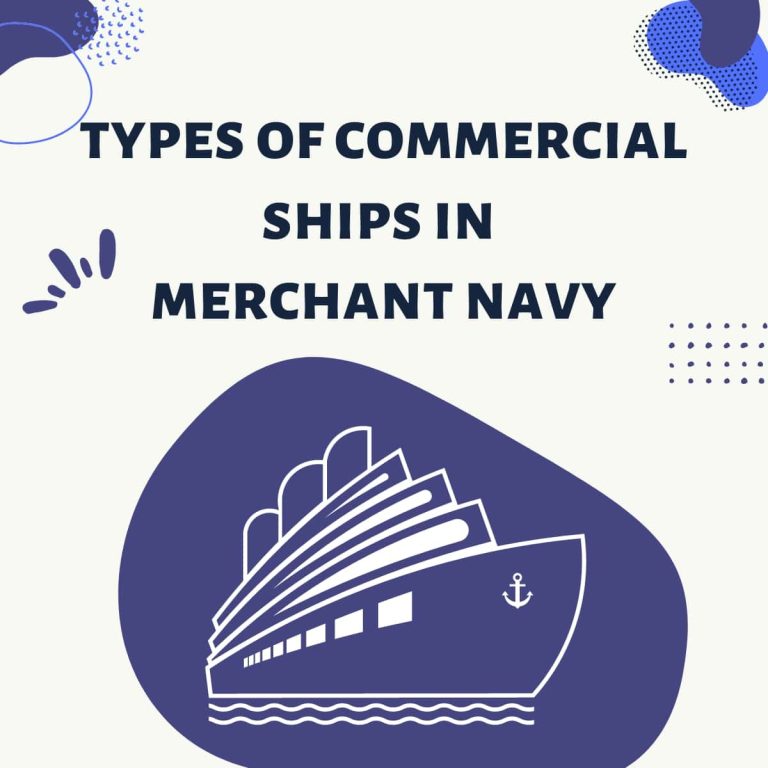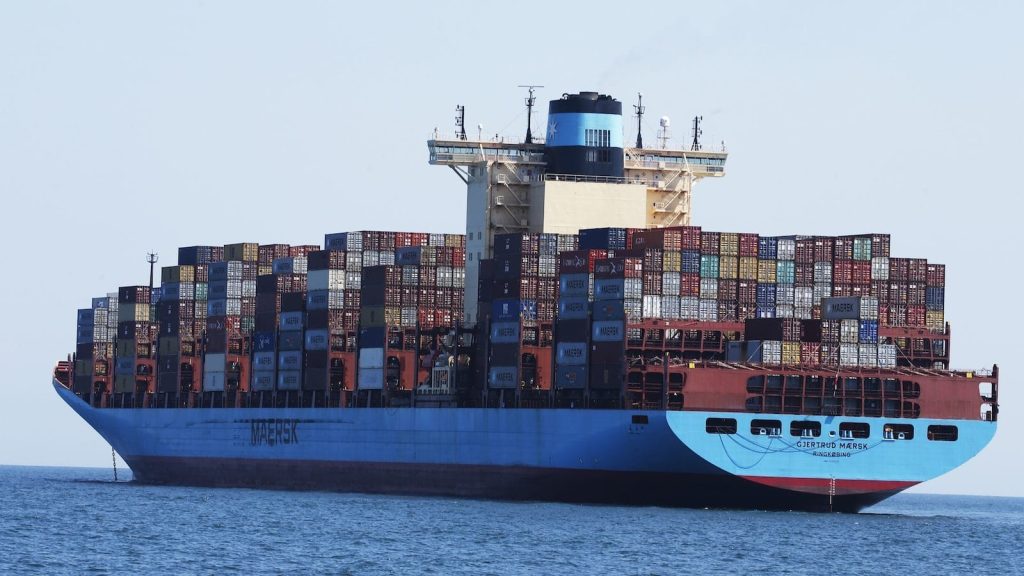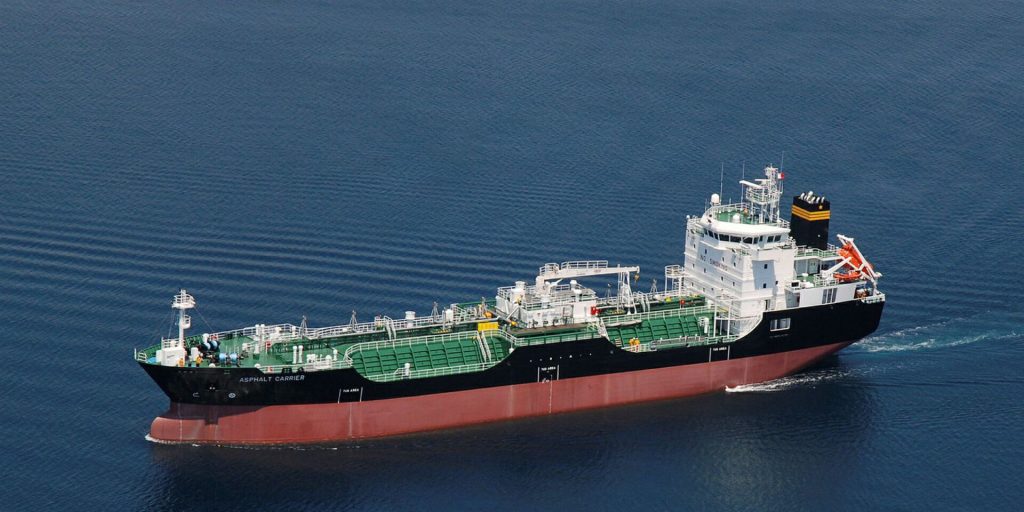
17 Types of Commercial Ships in the Merchant Navy
Commercial ships in the Merchant Navy are used to transport goods and passengers to different destinations. Merchant Navy ships come in an array of shapes and sizes, to enable them to complete their intended purpose. These ships, which range from freight liner ships to oil tankers, are all built to perform certain functions.
Commercial ships are categorized based on three characteristics: cargo capacity, weight, and size. A ship’s maximum dimensions, such as length and beam (beam), limit the number of canal locks it may pass through; water depth (draught) is a limitation for canals, shallow straits, and ports; and height is a constraint for passing under bridges. Ships are generally custom-built for the task, complete with cranes and other loading and unloading equipment, and come in a variety of sizes.
Table of Contents
Let’s have a look at 17 different types of commercial ships in the Merchant Navy.
1. Cargo ships

A cargo ship, often known as a freighter. It is a type of merchant ship that transports cargo, products, and resources from one port to another. Every year, thousands of cargo ships travel the world’s seas and oceans, carrying the majority of international trade.
Cargo ships are often expressly constructed for the role, generally outfitted with cranes and other systems for loading and unloading, and come in a variety of sizes. Cargo ships/freighters are divided into seven groups, on the basis of cargo that they carry.
They include feeder ships, general cargo vessels, container ships, bulk carriers, tankers, dry bulk carriers, multi-purpose vessels, reefer ships, and ro-ro vessels. We’ll have a look at all of these in the blog.
2. Container ships
A container ship, also known as boxship, is a cargo ship that transports all of its goods in truck-size intermodal containers, a process known as containerization. Container ships are a common kind of commercial intermodal freight transport and presently carry the majority of seagoing non-bulk cargo.
Container ships are among the biggest vessels on the ocean, and they are majorly used on liner routes. They have become a key form of transport for manufactured goods all over the world, and they are of standard dimensions to facilitate shipment.
Containers are commonly loaded using either specialist cranes or general-purpose cranes outfitted with container lifting equipment. However, some tiny cargo ships are capable of self-loading and unloading.
Types of Container Ships On Basis Of Sizes:
- Panamax
- Suezmax
- Post-Panamax
- Post-Suezmax
- Post-Malaccamax
3. Bulk carrier
A bulk carrier, also known as a bulker, is a commercial ship that is specifically intended to transport unpackaged bulk goods in its cargo holds, such as grains, coal, ore, steel coils, and cement. Since the first specialized bulk carrier was built in 1852, economic factors have pushed these ships to grow in size and complexity.
Bulk carriers of today are purpose-built to enhance capacity, safety, efficiency, and longevity. Bulk carriers now account for 21% of the world’s merchant fleets, ranging in size from single-hold mini-bulk carriers to massive ore ships capable of carrying 400,000 metric tonnes of deadweight (DWT).
4. Tanker ships

A tanker, also known as a tank ship, is a ship intended to carry or store large liquids or gasses. Tanker ships are mainly classified on the basis of the type of cargo and size of the vessel. The most common forms of tankships are oil tankers, product tankers, chemical tankers, and gas carriers.
Tankers also carry commodities such as vegetable oils, molasses, and wine. The size of tankers is also measured in deadweight (DWT) and as per their size. They are classified as Seawaymax, Panamax, Aframax, Suezmax, VLCC (Very large crude carrier), and ULCC (ultra-large crude carrier).
Aside from ocean or sea going tankers, there are also specialized inland-waterway tankers that operate on rivers and canals with cargo capacities ranging from a few hundred tonnes to several thousand tonnes.
5. Naval Ships
A naval ship is a military ship used by the navy. Naval ships differ from civilian ships in terms of structure and mission. In general, naval ships are resistant to damage and are outfitted with weapon systems, whereas troop transports have little to no weaponry. Warships are navy ships that are mainly built for naval combat, as opposed to support (auxiliary ships) or shipyard activities.
Warships guard the passing of military troops across the water to coastal locations where they may be landed and employed against enemy forces; they defend commercial shipping from enemy assault; they impede the enemy from transporting military forces by sea, and they attack the enemy’s merchant shipping.
6. Ro-Ro ships
Roll-on/Roll-off ships or ro-ro ships are cargo ships intended to transport wheeled goods such as automobiles, trucks, semi-trailer trucks, buses, trailers, and railroad cars that are driven on and off the ship on their own wheels or utilizing a platform vehicle such as a self-propelled modular transporter.
This is in opposition to lift-on/lift-off (LoLo) ships, which load and unload goods using a crane. When in port, RORO boats feature either built-in or shore-based ramps or ferry slips that allow goods to be conveniently moved on and off the vessel. Although small ferries that go across rivers and other short distances sometimes feature built-in ramps, the term RORO is usually reserved for huge oceangoing ships.
7. Cruise ships

Cruise ships are built to serve passengers with accommodations and entertainment, with an emphasis on onboard amenities and comforts. Cruises are intended to transport passengers between ports in accordance with a vacation plan, rather than from one destination to another.
The largest cruise ship can carry over 6,500 guests as well as 2,000 crew members, making the cruise industry a significant source of income and employment in the Marine Sector. The cruise industry is rapidly increasing over the world. Since 1990, the overall number of passengers has climbed by 7.5 percent each year, from 3.7 million to 32 million, growing at twice the rate of the global tourism industry.
If you are also interested in making a career on a Cruise, here are two blogs for you to learn more about the industry:
Also Read:
How to apply for Cruise ship jobs?: Career options and eligibility criteria
What type of jobs are available on Cruise ships?: Pay scale ranges
8. Offshore vessels
Offshore vessels mostly assist in oil exploration and construction at sea. There are several types of offshore boats. Some of them include the following:
- Supply ship: Vessels that supply to offshore rigs
- Crane barges or floating cranes: A crane vessel, crane ship, or floating crane is a ship with a crane specialized in lifting heavy loads
- Pipe layers: Vessels engaging in laying pipes and cables
- Semi-submersible Drill Rigs: These are Mobile Offshore Drilling Units to make stable platforms for drilling oil and gas
- Drill Ships: A drillship is a merchant vessel designed for use in exploratory offshore drilling of new oil and gas wells or for scientific drilling purposes
- Accommodation Barges: Could be a stand-alone floating hotel or can include accommodation as well as space for cargo
9. Fishing vessels

A fishing vessel is a boat or ship that is used to capture fish in the sea, on a lake, or in a river. Commercial, artisanal, and recreational fishing all employ a variety of vessels. Fishing vessels are mainly classified into two types – trawlers and non-trawling vessels.
- Trawlers, Purse Seiners: A fishing trawler, also known as a dragger, is a commercial fishing vessel that uses trawls to catch fish. Trawling is a type of fishing in which a trawl is actively dragged or pulled through the water behind one or more trawlers.
- Factory ships: A factory ship, also known as a fish processing vessel, is a large ocean-going vessel equipped with substantial onboard equipment for processing and freezing captured fish or whales.
10. Specialty Vessels
Specialty vessels are constructed and used for specific purposes. Some of the specialty vessels are listed below:
- Tenders: A boat used to service or support other boats or ships, generally to transport people and supplies.
- Pilot Crafts: Pilot crafts are used for the transportation of harbor pilots.
- Cable Layers: Cable laying vessels help in laying cables onto the seabed.
- Research vessels: They are specialized vessels used to conduct a range of sea-based research. Seismic vessels, hydrographic vessels, polar vessels, and oceanographic vessels are among the most popular research vessels.
- Livestock Carriers: Vessels that carry livestock/animals.
- Ice breaker ships: They are used to break ice formations in severely cold climates to make water navigable.
11. High-Speed Craft
High-Speed crafts are a special type of technologically sophisticated high-performance, usually high-speed, maritime vessels. Though the majority of these technologies are not employed in commercial boats, a handful have been successfully deployed and tested on small scale conventional merchant vessels.
Some of the main types of high-speed crafts are:
- Multihulls including wave piercers
- Small waterplane area, twin-hull (SWATH)
- Surface effect ship (SES) and Hovercraft
- Hydrofoil
- Wing in Ground Craft (WIG)
12. Dredgers

Dredging is an evacuation operation that is often performed underwater, in shallow oceans or freshwater environments, to gather bottom sediments and enlarge the channel. Dredgers are boats equipped with evacuation tools that are used to remove sand and other forms of deposits from the seabed.
They are extremely important because they provide the essential safe bottom clearance for safer trips. They are used for a variety of reasons, like making shallow coastal regions navigable deep-sea mining, etc.
Dredgers are mainly categorized into 3 types:
- Mechanical Dredgers: They include Bucket Dredgers, Bucket Ladder Dredgers, Grab Dredgers, and Backhoe Dredgers.
- Hydraulic Dredgers: Suction Dredgers, Trailing Suction Hopper Dredger, and Water Injection Dredger.
- Other Dredgers: Jet-lift Dredgers, Air-lift Dredgers, Augur Suction Dredgers, Reclamation Dredgers, Pneumatic Dredgers, Amphibious Dredgers, and Plough or bed leveler.
13. Gas carriers
They are sometimes grouped in with oil tankers, but have more advanced technology for storing liquefied gas. They are more technically sophisticated as compared to any other form of vessel, including bulkers and containers. Gas carriers can be divided into five types based on the type of cargo carried and the mode of transportation.
In broad terms, they are divided into LNG, which specializes in storing liquid natural gas, and LPG, which deals with liquefied petroleum gas. The main difference is technical, since LNGs carry gas at temperatures up to -170ºC and LPG at -50ºC, and at 18 Kg/cm2 pressure.
The delivery of alternative energy sources to clients across the globe adds to the global energy supply chain by assisting in meeting the global market demand for energy.
14. Bitumen/Asphalt carriers

Bitumen/Asphalt carriers are vessels designed specifically for carrying bitumen goods. The major characteristic of these ships is that they have floating tanks, which implies that due to the high temperature of the item they execute, the tanks can expand up to 260 degrees celsius.
Tanks are occasionally insulated to prevent the loss of heat. Bitumen carriers typically range in size from 1000 to 6000 DWT and transport oil from offshore petroleum plantations or fields to refineries in the lower part. The ships that come under this category belong to the true “sea giants”.
15. Reefer Ships
A reefer ship is a refrigerated cargo ship that transports perishable goods such as meat, fruits, vegetables, dairy products, and other goods that require temperature control. The holds of a reefer ship are specially insulated and cold air is pumped into them at proper temperature for the cargo.
The usage of cold containers carried onboard container ships has now largely replaced the need for traditional reefer boats. Reefer ships are built differently than conventional cargo ships and have various power generation and distribution systems.
Reefer ships may be generally categorized into 3 types: Side-door vessels, Conventional vessels, and Refrigerated container ships.
16. Tugs
A tugboat, often known as a tug, is a vessel that pushes or pulls other boats using direct contact or a tow line. These boats usually tow ships that cannot move on their own, such as those in congested harbors or small canals, or those ships that can’t move at all, including barges, damaged ships, log rafts, or oil platforms. Tugs are also used to transport huge constructions, such as offshore platforms and floating storage units, from one port to another.
Some of these are ocean-going, ice-breakers, and salvage tugs. Steam engines were generally used in the early versions of tugs, while diesel engines are used in the newer ones. Many of them also have deluge guns, which aid in the suppression of fires, particularly in harbors.
17. Sailing ships

A sailing ship is a seagoing vessel that propels itself by harnessing the power of the wind through sails fixed on masts. Sailing ships are propelled by a variety of sail designs, including square-rigged and fore-and-aft sails. From the 15th century to the middle of the 19th century, the usage of sailing ships was at its peak.
They were very important for both trade as well as for war. Because all big boats were dubbed “ships” with the invention of steam power, people began to refer to them as “steam ships” to distinguish them from “sailing ships”. Nowadays, these ships are generally used for leisure and tourism purposes.
Also Read: Online Sponsorship Exams for Merchant Navy in 2023: List of Companies
To sum up,
In, conclusion, these were the different types of commercial ships used in the Merchant Navy. All the major ships that one can come across are included above. If you know of any other ships, mention them in the comments!
And also, if you want to work on any of these ships, we’re right here! Check out our courses that will help you join the Merchant Navy!
Click here to join our Telegram chanel
You will get information, news, and support related to Merchant Navy.



